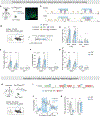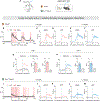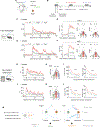Make war not love: The neural substrate underlying a state-dependent switch in female social behavior
- PMID: 34982958
- PMCID: PMC8897222
- DOI: 10.1016/j.neuron.2021.12.002
Make war not love: The neural substrate underlying a state-dependent switch in female social behavior
Abstract
Female mice exhibit opposing social behaviors toward males depending on their reproductive state: virgins display sexual receptivity (lordosis behavior), while lactating mothers attack. How a change in reproductive state produces a qualitative switch in behavioral response to the same conspecific stimulus is unknown. Using single-cell RNA-seq, we identify two distinct subtypes of estrogen receptor-1-positive neurons in the ventrolateral subdivision of the female ventromedial hypothalamus (VMHvl) and demonstrate that they causally control sexual receptivity and aggressiveness in virgins and lactating mothers, respectively. Between- and within-subject bulk-calcium recordings from each subtype reveal that aggression-specific cells acquire an increased responsiveness to social cues during the transition from virginity to maternity, while the responsiveness of the mating-specific population appears unchanged. These results demonstrate that reproductive-state-dependent changes in the relative activity of transcriptomically distinct neural subtypes can underlie categorical switches in behavior associated with physiological state changes.
Keywords: activity-dependent scRNAseq; female mice; internal state; maternal aggression; sexual receptivity; social behavior; state-dependent neural plasticity; ventromedial hypothalamus.
Copyright © 2021 The Author(s). Published by Elsevier Inc. All rights reserved.
Conflict of interest statement
Declaration of interests The authors declare no competing interests. D.J.A. is a member of the journal’s advisory board.
Figures







Comment in
-
Social switches.Nat Rev Neurosci. 2022 Mar;23(3):130-131. doi: 10.1038/s41583-022-00559-8. Nat Rev Neurosci. 2022. PMID: 35079172 No abstract available.
-
From mating to mama bear: Distinct VMHvl cell types drive female reproductive state-dependent behavior.Neuron. 2022 Mar 2;110(5):737-739. doi: 10.1016/j.neuron.2022.02.007. Neuron. 2022. PMID: 35240060
References
Publication types
MeSH terms
Grants and funding
LinkOut - more resources
Full Text Sources
Molecular Biology Databases

